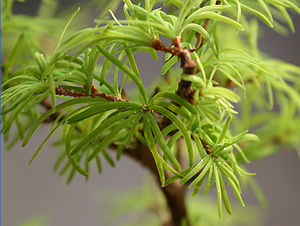Golden larch
| Golden larch | ||||||||||||
|---|---|---|---|---|---|---|---|---|---|---|---|---|

Golden larch ( Pseudolarix amabilis ) |
||||||||||||
| Systematics | ||||||||||||
|
||||||||||||
| Scientific name of the genus | ||||||||||||
| Pseudolarix | ||||||||||||
| Gordon | ||||||||||||
| Scientific name of the species | ||||||||||||
| Pseudolarix amabilis | ||||||||||||
| ( J. Nelson ) Rehd. |
The golden larch ( Pseudolarix amabilis ) is the only plant species of the genus Pseudolarix within the pine family (Pinaceae).
description
The golden larch is a deciduous tree that reaches heights of up to 40 meters and trunk diameters of up to 1.5 meters, from the main trunk of which the side branches extend horizontally. The bark is gray-brown.
The flattened, flexible needles are 2 to 5.5 centimeters long and 1.5 to 4 millimeters wide and thus wider than the larch ( Larix ). In autumn, the needles take on the yellow color that gives them their name, before they turn red and fall off.
The golden larch is single-sexed ( monoecious ), so there are female and male cones on a tree. It blooms in May. The male cones, which are terminally on short shoots in groups of 10 to 25 together, are initially upright and later hang. The female cones, which stand individually at the end of short shoots and upright on a short stalk, are 5 to 7.5 cm in length and 4 to 5 cm in diameter. They are green or purple-green during flowering and turn reddish-brown when ripe. The 18 to 30 thick, woody seed scales have a length of 2.8 to 3.5 and a width of about 1.7 cm. The cover scales have a quarter to a third of the length of the seed scales. When the seeds are ripe in October, the cones including the spindle disintegrate while still on the tree and release the seeds. The white, egg-shaped seeds are 6 to 7 millimeters in size with 2.5 centimeters long, light to brown-yellow wings.
The seedlings have (four to seven cotyledons cotyledons ).
Occurrence
The golden larch is originally found in the mountains of the eastern Chinese provinces of Zhejiang and Jiangxi , at altitudes between 500 and 1500 meters. It prefers deep, nutrient-rich, moist but well-drained soils and avoids lime . The golden larch was only introduced to Europe and North America in 1854 , where it generally only reached a height of just under 20 meters. Because of its autumn color , it is a popular ornamental tree .
Fossil evidence
More than seventy mentions of fossil evidence are known from the literature, which are clearly assigned to the genus Pseudolarix . The fossil evidence goes back to the Palaeogene . In addition to the recent species Pseudolarix amabilis described in this article, a second species - Pseudolarix wehrii - was identified from the material. Particularly revealing finds were made on Axel-Heiberg Island in the Canadian Arctic. Here (fossil) resins were preserved in situ in cones from Pseudolarix, among other things . A comparison of these resins clearly produced by Pseudolarix with other fossil resins led, among other things, to the result that Pseudolarix , like the mother plant of Baltic amber, produced resin that is based on polylabdanoid macromolecular structures and contains succinic acid , from which the conclusion was drawn that between these Plants probably have a phylogenetic relationship and either there must have been other fossil pseudolarices or the two resin producers have a common ancestor. In addition, these findings have stimulated the scientific discussion about the botanical origin of Baltic amber, which is still ongoing today.
Synonyms
Synonyms for the genus Pseudolarix Gordon are: Laricopsis Kent non Fontaine and Chrysolarix H. E. Moore .
Synonyms for the species Pseudolarix amabilis (J. Nelson) Rehd. are: Larix amabilis J. Nelson , Laricopsis fortunei (Mayr) Mayr , Chrysolarix amabilis (J. Nelson) HE Moore , Pseudolarix fortunei Mayr , Pseudolarix pourtetii Ferré .
swell
- Christopher J. Earle: Information on the species at The Gymnosperm Database, 2007. (English)
Individual evidence
- ↑ Ken B. Anderson and Ben A. LePage: Analysis of Fossil Resins from Axel Heiberg Island, Canadian Arctic. In: Amber, Resinite, and Fossil Resins. ACS Symposium Series 617, Washington, DC, 1995
Web links
- Image. ( Memento from July 19, 2007 in the Internet Archive )
- Pseudolarix amabilis in the endangered Red List species the IUCN 2008. Posted by: Conifer Specialist Group, 2000. Retrieved on December 31 of 2008.

